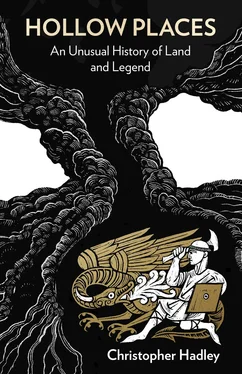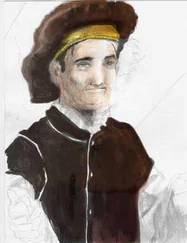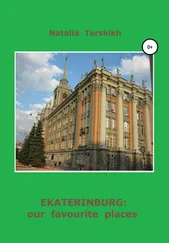HOLLOW PLACES
An Unusual History of Land and Legend
Christopher Hadley

William Collins
An imprint of HarperCollins Publishers
1 London Bridge Street
London SE1 9GF
www.WilliamCollinsBooks.com
This eBook first published in Great Britain by William Collins in 2019
Copyright © Christopher Hadley 2019
Cover illustration by Joe McLaren
Christopher Hadley asserts the moral right to be identified as the author of this work
A catalogue record for this book is available from the British Library
All rights reserved under International and Pan-American Copyright Conventions. By payment of the required fees, you have been granted the non-exclusive, non-transferable right to access and read the text of this e-book on-screen. No part of this text may be reproduced, transmitted, down-loaded, decompiled, reverse engineered, or stored in or introduced into any information storage and retrieval system, in any form or by any means, whether electronic or mechanical, now known or hereinafter invented, without the express written permission of HarperCollins.
Source ISBN: 9780008319472
Ebook Edition © August 2019 ISBN: 9780008319519
Version: 2019-06-28
To my dad Harry Raymond Hadley, and in loving memory of my mum Joan Mary Hadley, a born storyteller
Dummling set to work, and cut down the tree; and when it fell, he found in a hollow under the roots a goose with feathers of pure gold.
—‘The Golden Goose’ in German Popular Stories , collected by Jakob and Wilhelm Grimm, from oral tradition, London, 1823
Contents
Cover
Title Page
Copyright
Dedication
Epigraph
Part I: Tree
Chapter 1
Chapter 2
Chapter 3
Chapter 4
Chapter 5
Chapter 6
Chapter 7
Chapter 8
Chapter 9
Chapter 10
Part II: Stone
Chapter 11
Chapter 12
Chapter 13
Chapter 14
Chapter 15
Chapter 16
Part III: Story
Chapter 17
Chapter 18
Chapter 19
Chapter 20
Chapter 21
Chapter 22
Chapter 23
Chapter 24
Part IV: Name
Chapter 25
Chapter 26
Chapter 27
Chapter 28
Chapter 29
Chapter 30
Chapter 31
Chapter 32
Part V: Last Things
Chapter 33
Chronology and select textual history
Notes
List of illustrations
Index
Acknowledgements
About the Author
About the Publisher

THE SHONKS EPITAPH, BRENT PELHAM. — I should be grateful for information regarding the epitaph on O. Piers Shonks in Brent Pelham Church, Hertfordshire. The tomb of this worthy lies in a recess cut into the north wall of the church and bears the following inscription in Latin (I quote from memory):—
Tantum fama manet Cadmi Sanctique Georgi Postuma; tempus edax ossa sepulchra vorat.
Hoc tamen in muro tutus qui perdidit anguem Invito positus Daemone Shonkus erat.
There is also a neat rhyming translation in English which I cannot recall.
Who was Shonks? What is the point in the reference to Cadmus and St. George (in itself a curious conjunction of names)? What is the significance of ‘who destroyed the snake’ (the Devil?) as applied to Shonks? What is the point of ‘invito Daemone’?
I understand that a field in the village still bears the name ‘Shonks’ field.’
D. C. THOMPSON.
Notes and Queries , 1932
In the High Middle Ages, on the Hertfordshire–Essex border, a remarkable tomb was carved out of grey-black marble to cover the bones of an English hero whom legend calls Piers Shonks. For centuries, tales about dragons, giants and the devil have gathered around the tomb and spread into the surrounding countryside. How and why that happened is the subject of this book: it is both a historical detective story and a meditation on memory, belief, the stories we used to tell – and why they still matter.
Part I
Tree
I begin on the edge of Great Pepsells field on a cold winter’s morning in the early nineteenth century.
LITHETH AND LESTENETH AND HERKENETH ARIGHT
She was the oldest living thingthereabouts.
Alone, on the wide plateau between the rivers Ash and Quin, the old yew tree had stood since time out of mind and beyond the memory of man.
Did old Master Lawrence think of her great age when he tested the cold edge of his felling axe that winter’s morning? He would have known that bringing her down was going to be an ’umbuggin job, but he had no idea how things would turn out; that before the day was over he and his axe would become part of a story already ages old. Two hundred years hence, people would still be talking about the yew in Great Pepsellsfield, of the day she fell and of what the woodcutters found in her roots.
For some twenty yearsnow she hadstood alone: resolute but incongruous in that heavy-clay field where tracks and parishes met; her evergreen boughs prey to lightning, the knots and sinews of her trunk rivened by wind and hail. She had once marked the northernmost boundary of a wood, but the acres of ash and maple had been grubbed up in the years between Trafalgar and the death of Old Boney.
Perhaps the landowner, or his steward, had left her standing for her grandeur. Generations must have paused to admire her or sheltered beneath her thick crown. Children, dallying on their way to gather brushwood or flintsor rushes, would have carved their names in her barkand picked her blood-red arils – breakfasting on the bitter fleshand spitting the poisonous seeds to the ground.
The tree stood in the village of Furneux Pelham, 500 yards from the parish boundary. Half a mile further east across the level fields rose the tower and Hertfordshire spike of St Mary the Virgin in Brent Pelham. That the church was the only building in sight is not incidental, nor was the presence of yet another parish boundary just 200 yards to the west along the widening ditch: strange things happenwhere three parishes meet.
There she grew in this remote spot near the Hertfordshire–Essex border, within five or six feet of where a Roman roadlay beneath the soil of the field. (Did her shadow once fall on the Eagle of the Ninth?) Trees of that age – like the famous churchyard yews at Tandridgeand Crowhurstin Surrey – have many textures: on one face she might be red and hairy and corded, a trunk of immense ropes twisted into terrible strength, yet on another, bleached and moth-eaten, misshapen like driftwood. From certain angles, in certain lights, vermicular, flayed, mutating.
She had grown into a storybook tree, long before she became part of a story.
They say that she had ‘split open, as such trees do, with extreme old age’. A great wound. Split enough and large enough to have a stile and steps set in her trunk. The Reverend Soames, pursuing rumours of pigletsor turnips (one in every ten was his), might easily follow the track across Pipsels Mead and Nether Rackets, through the great tree into Pepsells, and on through Long Croft or Lady Pightle towards Johns a Pelham Farm.
Was she as prodigious as the yew at Crowhurst with its small door set in its hollow trunk? Or more wonderful still? Like the greatest of all surviving British yews at Fortingallin Perthshire. Once fifty-six feet round there was plenty of space between her trunks through which to lead a horse and cart. Today, both trees are thought to have taken seed in the reign of the Emperor Augustus.
Читать дальше














